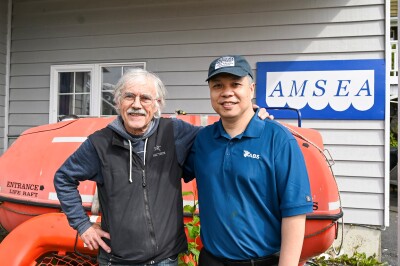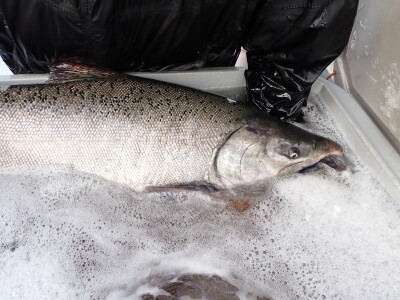Northeast
A 47-footer has Mass. appeal; Maine builder buys Beal molds
H&H Marine is building several boats at its shop in Steuben, Maine, for commercial fishermen in New England, the West Indies and California.
In December, the boat closest to being finished was for Peter Krzyzewski of Kingston, Mass. It measures 47' x 19' 2" x 5' 10". "It will do everything, from lobstering to dragging to gillnetting," says H&H Marine's Bruce Grindal.
The 47-foot hull is a fairly new model for H&H Marine, and is only the third one to come out of a mold. What makes this one different from the previous two is that the sheer line was raised 1 foot all the way around the hull.
Moving the sheer allowed the yard to raise the deck 12 inches. "That will give him more storage capacity," Grindal says. That includes an insulated fish hold with a 28,000-pound capacity.
The skeg and sternpost were pushed aft. "The standard 47 swings a 40-inch prop. He wanted to swing a 48-inch prop, so we moved the skeg and sternpost to accommodate that," Grindal explains.
The hull is solid fiberglass with a molded Divinycell-cored top over a split wheelhouse. The deck area where the trawl winches will be bolted down has been doubled up and the reinforcing is tied into the stringers.
Down in the engine room is a 12.5-liter John Deere main engine rated at 400 hp.
Bolted to the engine is the marine gear with a 3.5:1 reduction. With the deck raised 12 inches, Grindal, who is about 5 feet 10 inches tall, can stand in front of the engine and his head is just under the deck. The boat's hydraulics will be driven off the transmission.
The current plans are for Krzyzewski to do some finishing work on the boat at H&H Marine, launch it at nearby Milbridge, and then sail it to Massachusetts where the hydraulics and fishing gear will be installed.
Next to Krzyzewski's boat is a 39-foot 5-inch boat that will be going to Martinique in the French West Indies. The boat was laid up in a 42-foot mold that was plugged at the stern to produce the shorter hull. The owner "wanted it that way, because the wide 42 is a little fuller and deeper than the standard 40," Grindal says.
Next to the boat for Martinique is a nearly completed kit boat for a lobsterman in Rockport, Mass.
H&H Marine installed the top, the shaft and rudder. The owner will do the rest of the work. Grindal says a detuned John Deere, rated at 235 hp, is going into the boat.
In another building in the early part of December, a 47-foot hull was being laid up for a crab fisherman in San Francisco. The crab boat will have an 800-hp Caterpillar C15 for the main engine. She is due to be completed this spring.
The molds for the hulls of the Beals Island, Maine, boatbuilder and designer Calvin Beal Jr. have been bought by SW Boatworks says the boatshop's owner, Stewart Workman. After Thanksgiving, the molds were trucked from shops in Rockland and Belfast, Maine, where previous hulls had been built, to Workman's shop in Lamoine, Maine.
"We'll bring the molds back and do a little work on them. We'll spruce them up and get them ready for some orders," says Workman, adding, "The molds are very wide for their length. They make a good platform to work out of."
Four molds were delivered to SW Boatworks: 34' x 13' (12' 4" at the transom), 36' x 13' 9" (13 feet at the transom), 38' x 15' (14' 2" at the transom) and 44' x 17' 6" (16' 2" at the transom).
SW Boatworks will layup the hulls and finish off them off, though if it is too busy to do the work, the hulls and tops will be sent out to finishers. And Workman says he will be selling kit boats to fishermen who want to build their own boats.
Currently, SW Boatworks is finishing a 38-foot Wesmac hull for sportfishing and will be building another 38-foot Wesmac hull on speculation. — Michael Crowley
West
Seiner gets major going-over; preparation key to sponsoning
The limit seiner and longliner Equinox was due to go in the water Jan. 3 after an extensive refurbishing at Platypus Marine in Port Angeles, Wash.
The 58-footer looked worse for the wear when the boatyard's TraveLift picked the blue and red steel-hulled boat out of the water and carried it into the repair building. "She was in pretty rough shape," says Platypus Marine's Charlie Crane of the boat built in 1991 by Tim Alls Boat Building in Seattle.
After 90 percent of the boat was sandblasted, most of the grime and rust that had built up from years of fishing Alaskan waters was gone.
The mast was cut off for sandblasting, painting and rewiring. All new antennas and radars went back on the mast.
The mast's booms came off and were sent out to be regalvanized. The winches were also sent out to be rebuilt.
All hydraulic lines, valves and hoses were removed. The valves were completely gone over. "The valves were only 4 years old, but they wanted them looked at, and they had to pull them off for the paint job," says Platypus Marine's Bruce Bryant.
There had been a problem with seawater getting into the fuel tanks in rough weather. After it was determined that the venting system, which was in the cap rail, was the source of the problem, all the fuel tank venting was cut out.
"All the existing holes [for the venting] in the deck and the top of the tank were plugged," Bryant says. Then stainless steel venting was rerouted through the boat's interior and run up the back of the wheelhouse.
The Platypus crew took out the pilothouse windows, rebedded and fastened them back in place.
Back at the stern, they installed a new rudder bearing along with a new stern-tube bearing and a pillow block bearing in the shaft alley.
Then the crew used an Ameron paint system on the sandblasted Equinox. "We've had really good luck with this system. It's used on oil rigs, bridges, stuff that's exposed to the elements," Bryant says.
After the decks were sandblasted and cleaned up they got a coating of polyurea. Polyurea can be sprayed on about as thick as you like. "Some spots where the trawl doors or seine rings hit the inside of the bulwarks, they want it a half-inch thick," Bryant notes.
Down in Crescent City, Calif., the Roller Bay, a boat that spends most of its time fishing in Alaska, arrived at Fashion Blacksmith for a sponsoning job the second week in December.
It's a homecoming event of sorts for the Roller Bay, which was built in Crescent City at the end of the 1980s by the late Duke Adams for a local fisherman. Back then she was named the Last Chance and was used off California as a tuna boat and Dungeness crabber, says Fashion Blacksmith's Ted Long.
The boat's next owner was Dick Prettyman a Washington state salmon seiner who sold her to Ron Johnson, a Dungeness crabber and salmon seiner.
The Roller Bay measures 58' x 16'. When she leaves Fashion Blacksmith in March, the boat will have another 8 feet at the beam. Long says the sponsoning will add carrying capacity and reserve buoyancy, as well as improve stability.
Johnson seems to be a guy who plans things out very carefully. In anticipation of the sponsoning work, he repowered last year with a 400-hp John Deere, and about a year before that the boat got a bulbous bow.
Johnson did the repowering and the bulbous bow work himself, Long says. "He upped the horsepower and made the bulb the right diameter for the larger boat." Johnson made the bulb from 4 feet of schedule-80 pipe that had been the base to a ski tower, "and he did a good job of it," Long says.
In preparation for the sponsoning job, the crew at Fashion Blacksmith cut away 12 feet of the bow area from the fo'c'sle deck, down to the water tank or about the chine, Long says. "That's to get rid of the old plate to eliminate the double hull and extra weight up forward," he explains. Eliminating the original plating will also make the bunk area wider.
From the engine room aft, most of th
e original plating will remain, except for some selected areas in the engine room where plating will remain to gain additional space. — Michael Crowley
South
'Bama yard builds a scalloper; huge gear shuts down railway
Williams Fabrication of Coden, Ala., is building a new scallop boat and converting a Gulf of Mexico shrimper into a longliner.
The scalloper's hull is completed and measures 90' x 27'. In early November, the crew at Williams Fabrication was waiting for a crane to lift and roll the hull before starting the top work, says the boatyard's Lane Williams.
A 6-cylinder 700-hp Lugger L6178.4C diesel will power the scalloper. The engine will work through a Twin Disc 6.5:1 reduction gear that turns a four-bladed prop.
With the depressed shrimp business, Williams, as well as other southern yards, is converting shrimp boats for other fisheries. In this case, a 72' x 26' shrimper is being turned into a longliner for Fleet Fisheries in New Bedford, Mass.
Williams says, "These conversions are providing work for us and other yards. The hulls on these boats are perfectly fine and convert well for other fisheries."
The new scalloper is the fifth boat Williams Fabrication has built for Fleet Fisheries. All five have been of different sizes to meet permit requirements.
In the Chesapeake Bay region, Smith's Marine Railway in Yorktown, Va., was hauling an 86-foot wooden scallop boat on Nov. 3 when the railway's main gear broke.
The gear was cast in Philadelphia in 1856. For 152 years, the 4-foot-6-inch-diameter gear performed without failure. "It's pulled every boat we have hauled since 1856," says the yard's Tim Smith. (The boatyard was founded in 1842.)
The railway was built before combustion engines, and the yard's first form of horsepower to haul boats was the four-legged kind. Smith says every part of the railway had been replaced with the exception of this gear. "It had very little wear, despite its age," he says.
"When the vessel was almost out of the water, the gear slipped, broke a tooth and started throwing teeth in all directions," he explains.
The marine railway is a family-owned operation, and two of the brothers were standing close to the gear when it broke but were able to get away without being injured.
A replacement gear was being custom built and was expected to be finished in a couple of weeks. Without the capacity to haul boats, Smith says work has not stopped at the yard. He has two crews working away from the boatyard doing top-work jobs on wooden boats.
"We are fortunate we have some work that can be done without hauling," he says. "I hope this new gear will last as long as the old one."
Ampro Shipyard in Weems, Va., has a couple of projects underway. The oyster-seed planter Captain Ellery, owned by Kellum Seafood in Weems, is on the rails.
Fifteen feet of the stern's plating was replaced with 3/8-inch and 1/4-inch steel. A new 3-inch shaft and a new Duramax cutlass bearing were installed, along with a new stuffing box. In addition, some old water-pump motors were replaced with new electric motors that will be used for planting seed oysters.
On the Chesapeake there are several ways to plant seed oysters. Kellum Seafood uses the modern technique of broadcasting spat with a stream of water that blows the oysters over the side.
"We were using an old diesel motor with hoses that we used to throw over the side for intake," says Tommy Kellum of the seafood firm. "Ampro installed a water system throughout the vessel so that now we have pipes fixed in the boat rather than having hoses spread all over the place," he says.
The Captain Ellery is used to plant and dredge seed oysters on Kellum's private oyster grounds and in the state of Virginia's oyster-seed planting program.
Also, Omega Protein of Reedville, Va., had Ampro installing and rebuilding main engines in the steel hulled 175' x 35' Gulf Island. Omega uses the boat as a transporter at its Reedville menhaden plant.
Ampro had to remove an exhaust stack to lift the starboard Caterpillar 399 engine out of the boat. Ampro will rebuild the engine over the winter. In the meantime, it was replaced with a spare so the boat could keep operating. The port engine had a top-end rebuild, which did not require removal. — Larry Chowning






